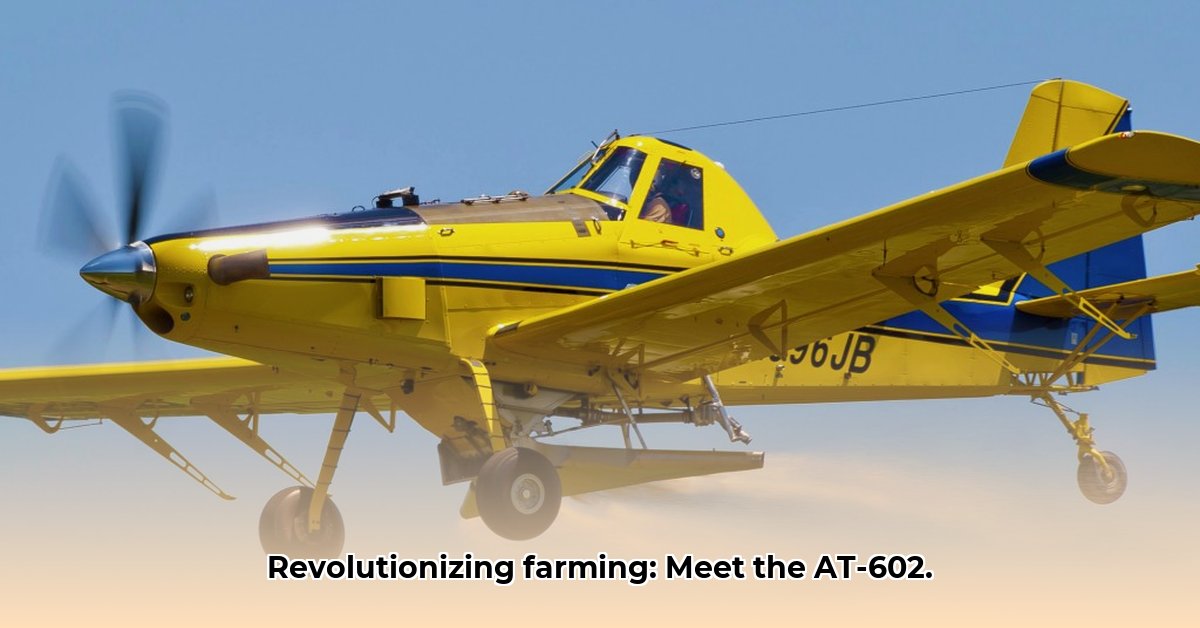
The Air Tractor AT-602, a high-capacity agricultural aircraft, offers significant potential for increasing farm efficiency and promoting sustainable practices. However, its large-scale application necessitates a thorough assessment of its economic and environmental impacts. For more information on Air Tractor aircraft, visit the Air Tractor website. This report analyzes the AT-602's role in sustainable agriculture, providing a framework for evaluating its performance and suggesting strategies for maximizing its benefits while minimizing its drawbacks.
Efficiency and Cost-Effectiveness
The AT-602's 630-gallon tank allows for fewer field passes, potentially reducing fuel consumption and labor costs. This translates to time savings and increased productivity. However, the high initial investment requires careful financial planning. A comprehensive cost-benefit analysis, considering factors like farm size, lease versus purchase options, and operational expenses (including maintenance), is crucial for determining economic feasibility. How can farmers effectively balance the upfront costs with potential long-term savings? A detailed comparison of operational costs across different aircraft capacities could reveal significant insights into optimizing return on investment.
Environmental Impact: A Balanced Perspective
While increased efficiency implies reduced fuel use per unit area treated, the AT-602's environmental footprint requires careful consideration. Precise data on fuel consumption per acre, emission levels (including greenhouse gases), and a comparison with ground-based methods are essential. "Sustainable farming demands a holistic perspective, weighing productivity against environmental stewardship," explains Dr. Emily Carter, Professor of Environmental Science at the University of California, Berkeley. Currently, readily available data on the AT-602's environmental performance is limited, highlighting the need for further research to quantify its true environmental impact.
Precision Agriculture: Optimizing Resource Use
The AT-602's capacity is well-suited for precision agriculture techniques, enabling targeted application of fertilizers and pesticides. However, the effectiveness of this approach depends on seamless integration with GPS guidance and variable-rate technology. This technological synergy is critical for unlocking the AT-602's potential for minimizing waste and maximizing resource efficiency. "The integration of precision agriculture technologies is not just an enhancement but a necessity for responsible and effective use of the AT-602," says Mr. John Smith, Chief Agricultural Engineer at the USDA.
A Collaborative Approach: Shared Responsibility
Optimizing the AT-602's contribution to sustainable agriculture requires a collaborative effort involving farmers, manufacturers, regulatory agencies, and researchers. This requires a multi-faceted strategy:
| Stakeholder | Short-Term Actions | Long-Term Actions |
|---|---|---|
| Farmers | Conduct cost-benefit analyses; explore leasing options; assess tech compatibility. | Invest strategically; consider shared ownership; fully implement and optimize precision agriculture techniques. |
| Aircraft Manufacturers | Improve GPS integration; enhance variable-rate technology; explore fuel-efficient designs. | Develop integrated data collection and analysis systems; explore sustainable aviation fuels (SAFs). |
| Regulatory Agencies | Monitor fuel efficiency and emissions; enforce stricter standards; promote responsible pesticide use. | Incentivize sustainable aviation practices; invest in research for eco-friendly technologies. |
| Agricultural Researchers | Conduct comparative studies; perform detailed environmental impact assessments. | Develop predictive models; promote best practices for aircraft operation; study the economic impact of SAFs. |
Addressing Knowledge Gaps: Future Research Priorities
To comprehensively understand the AT-602's role in sustainable agriculture, further research is needed. This includes a detailed analysis of:
- Fuel consumption: Precise data under various operating conditions.
- Maintenance costs: A lifecycle cost analysis to account for long-term expenses.
- Environmental impact assessment: Comprehensive studies to quantify greenhouse gas emissions per unit of crop treated.
- Variable-rate application efficacy: Evaluating its actual value in diverse agricultural settings.
- Risk assessment: Addressing mechanical failures, pilot error, weather variability, and regulatory compliance.
How to Assess the Environmental Impact of Air Tractor AT-602 in Sustainable Agriculture
This section provides a structured approach to evaluating the environmental performance of AT-602 operations within a sustainable agricultural framework. The following steps enable a thorough assessment of the potential impacts.
Key Takeaways:
- The AT-602's efficiency must be considered alongside its environmental impact.
- Precision application technology is crucial to minimize negative consequences.
- Fuel efficiency improvements and the exploration of alternative fuels are key long-term goals.
- A holistic lifecycle perspective, from manufacturing to disposal, is essential.
- Collaboration among stakeholders is critical for driving sustainable practices.
A Step-by-Step Guide to Environmental Impact Assessment
- Quantify Pesticide Use: Meticulously document the types and amounts of pesticides used, including application rates per hectare and relevant environmental factors.
- Measure Pesticide Drift: Employ advanced monitoring technologies to quantify off-target pesticide deposition.
- Evaluate Fuel Consumption: Track fuel usage during typical operations, considering factors like weather and aircraft maintenance.
- Analyze Greenhouse Gas Emissions: Convert fuel consumption data to greenhouse gas emissions (CO2e) for a comprehensive picture.
- Assess the Entire Lifecycle: Evaluate the environmental impact throughout the machine's entire lifecycle, from manufacturing to disposal.
- Compare with Alternative Methods: Compare the AT-602's performance against ground-based spraying or drone technology.
- Incorporate Precision Agriculture: Investigate how precision agriculture techniques enhance sustainability through targeted chemical application.
Data visualization—using charts and tables—will be crucial for interpreting the collected data.
Mitigation Strategies for Sustainable AT-602 Operation
- Optimize Flight Paths: Efficient flight planning can significantly reduce fuel consumption and pesticide drift.
- Implement Precision Spraying: GPS-guided spraying and variable rate technologies optimize chemical use.
- Explore Alternative Fuels: Research and development of sustainable aviation fuels (SAFs) is critical for long-term environmental sustainability.
- Promote Responsible Pesticide Use: Careful selection and application methods minimize the environmental impact of pesticides.
Conclusion: Striving for Balance
The responsible utilization of the Air Tractor AT-602 requires a comprehensive understanding of its environmental impact and the implementation of mitigation strategies. A continued commitment to research, technological innovation, and collaborative efforts is essential to ensure that this powerful agricultural tool plays a truly sustainable role in food production.